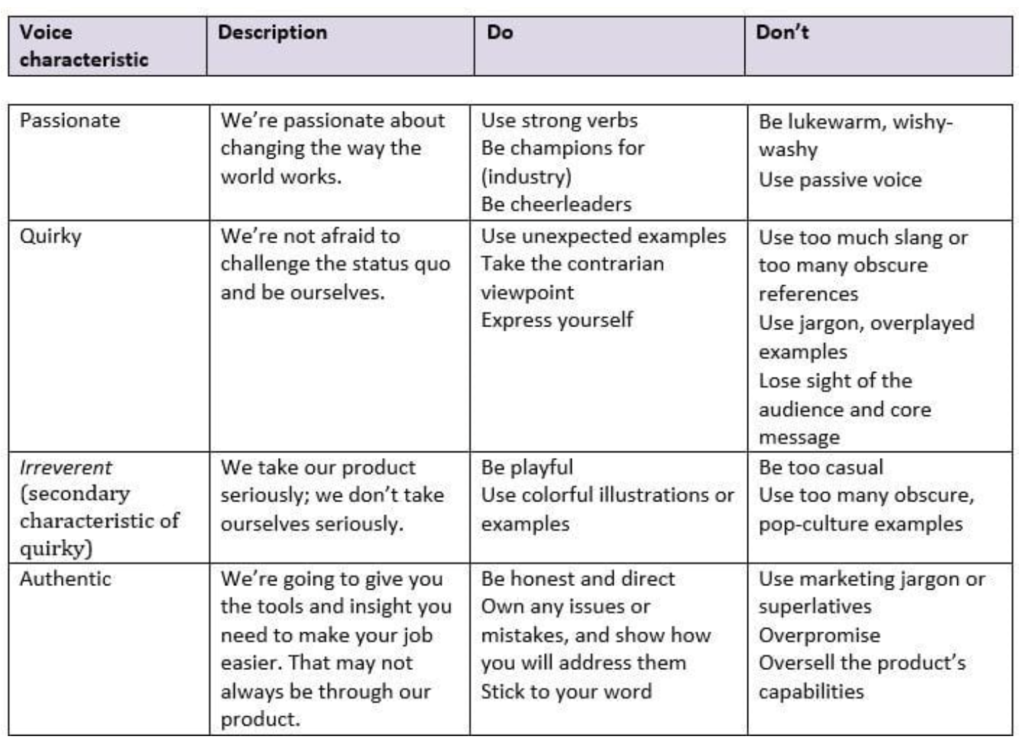This week we continue our series about voice and tone, and take a moment to talk about conversational writing style, and how it can help win the hearts and minds of customers. Let’s jump right in!
How to win customers with a conversational writing style

Conversational writing
Conversational writing is a powerful way to reach and convert customers. Whether in the context of web and email copywriting or product-focused UX writing, what you say is very much about how you say it.
When rooted in a strong understanding of your target customer, conversational writing can be a highly effective way to connect emotionally, inspire loyalty, and influence your prospects’ behavior.
Why use conversational writing?
Conversational writing connects with your reader and establishes a brand personality. You may opt with a voice that’s a little silly and informal, or one that’s more gentle and wise. Whatever the case, a conversational voice can humanize your product or brand, and establish a more direct, personal relationship with the person reading your content.
Conversational writing vs. traditional web copywriting
Conversational voice can feel like a big pivot away from traditional content writing or the kind of academic writing you learned in English 101. It takes the bold approach of eliminating formalities and speaking directly to the reader.
Here’s an example:
Traditional web copy: Preston Pool Supplies is the premier supplier of pool supplies in the greater Tampa region.
Conversational: Hey there, welcome to Preston Pool Supplies. We sell all the pool supplies you need for your Tampa area home.
You can see how, in the example above, the brand dialogues directly with the reader. In doing this, the brand is embodied through a brand persona, exhibiting character nuances that are meant to appeal to the ideal customer.
How to write conversationally
So, how to write in a conversational style? The key is speaking to your audience similar to how you’d speak out loud. But keep in mind your writing doesn’t operate in a vacuum. Rather, it needs to be authentic, and to resonate with your audience in all the right ways.
But how to be authentic? First, you need to have a tangible understanding of your target customer(s). After all, you’d write differently to appeal to a twenty-year-old college student than you would to the head of a corporate accounting department, wouldn’t you?
Most of us understand conversational writing instinctively, but if this is new to you and your brand, you’ll want to get specific. Is the language more casual and down-to-earth, or a little more serious and formal? Which expression would your brand voice use? – “Hello, there,” “How ya doin’,” or “Wassup?”?
Let’s explore how to capture the conversational nature of your brand.
Your mission and values
While your target customer is your north star, your brand purpose, mission, and values are your compass. A company in the hospitality industry for example, may have values such as generosity and caring. These values will be naturally expressed in their language style and choices.
Beyond mission and values, you’ll want to take into account your market competitors. How will your brand stand out from the pack? A strong brand voice can help your brand differentiate itself from the rest. In fact a strong brand voice is some brands’ most important assets.
A good time for a workshop
After looking at the big picture, it’s time to get down to the nitty gritty. You have a good grasp of your target customers and your company mission and values. Now you can establish your brand voice characteristics, as well as do’s and don’ts of writing for your brand.
The process of establishing your brand voice characteristics is often done in a workshop, with cross-disciplinary participation by your team. You can include executive leadership, marketing managers, customer service reps, writers, designers, and more. You can even survey customers for their opinions. Each individual is going to have a different perspective, and the more diverse points of view you survey, the better.
You’ll want to put all opinions on the table, and then work to find consensus using your brand strategy and positioning to guide the conversation. This process of honing in on your brand voice traits helps create buy-in, ensuring your whole team is invested in applying brand voice across the whole range of customer touch-points.

The final version of your brand voice characteristics will be documented in your voice and tone guidelines — a very important part of your brand style guide or brand book. This will become an important resource for anyone writing for your brand, and a great way to keep your conversational writing style on point.
Here’s an example, from the Content Marketing Institute, of how some companies document their brand voice characteristics:

Conversational guidelines for your style guide
Your style guide is the place where you outline the rules and principles for writing for your brand. These guidelines usually start with voice and tone and then move on the norms of grammar, punctuation, and spelling. All parts of the style guide are designed to help your writers be more on-brand.
The following are common guidelines for conversational voice. They may be found in the Voice and Tone or Usage section of your style guide:
- Use an informal 2nd person POV. Speak directly to the reader using the term “you.”
- Keep sentences short and concise. Always keep things simple – don’t drone on.
- Use an active vs. passive voice. Instead of “All challenges have been faced.” (passive) say, “We’ve faced all challenges.” (active).
- Embrace contractions. Instead of “Who does not love ice cream?” say, “Who doesn’t love ice cream?”
A note on casual tone: you will definitely want to consider how informal your brand voice should be. Some brands embrace slang, idioms, and words like “shoulda” “gotta” and “gonna,” whereas others would shy away from those terms.
Conversational voice examples
Example 1: Southwest Airlines
Southwest Airlines is a great example of a company that uses a casual conversational voice to great effect. Note how, in the example below, they lean into phrases like “We’ve got ‘em.” and “Wanna get away?” They’ve even gone so far as to label two of their fare categories as “Wanna get away” and “Wanna get away plus” to pump up the emotional tone of the cheaper fares.
Southwest Airlines expresses their purpose as to “Connect people to what’s important in their lives through friendly, reliable, and low-cost air travel.” You can certainly see their purpose reflected in their email copy below.

Example 2: Mailchimp
Mailchimp also speaks directly to their small business customers with a friendly, supportive voice. While informal in tone, they aren’t as casual as some of the direct-to-consumer brands. They position their company as an ally for small business owners who are chronically overworked and strapped for time. “We’ve got your back” is more real and honest sounding than a phrase like “We do everything we can to help our customers.”

Example 3: Jack in the Box
Jack in the Box is known for their humorous, often irreverent voice, personified in the character of Jack. Over the years, they’ve garnered a lot of popularity as a brand unafraid of taking risks. The casual, jokey tone using a lot of slang and idioms, extends to their website copy. Note phrases like “bow to the Cluck” and “it’ll have you doing your best chicken dance.”
Jack in the Box, like the other brands we’ve examined, knows their audience. You can see how their copywriting would connect well with budget-conscious fast food consumers – especially the college set and those with late-night cravings.

Have fun and don’t be intimidated
It’s easy to be awed by the seamless brand voices of large corporations. Of course, they’ve got million-dollar ad, sales, and marketing teams on their side! However, the principles we’ve explored apply just as easily to the mom-and-pop shops with a writing team of one or two. The keys are clarity, consistency, and specificity at every turn. And don’t be afraid to have a little fun along the way!
In conclusion
While conversational writing is not for every brand, it can be a highly effective way to connect emotionally with your customer. This makes your business more memorable, supports stronger relationships, and makes selling easier. Take time to understand your customer and craft a voice that connects. The effort will pay off.
If you’re exploring brand voice, tone, or conversational writing style, and would like some help from our content creation team, get in touch.
We love the process of helping businesses find their voice. For more voice and tone examples from the big brands, check out our article, Voice and Tone in Action.
Resources
We believe in giving credit where credit is due. Here are some of the amazing resources we tapped when writing this article:
UX Content Collective — check out their coursework and certificate programs on UX writing and content design
Conversational vs. casual — the different tones in UX writing by Yael Ben-David
The Very Good Copy newsletter has many great insights on copywriting
Copyblogger — more valuable copywriting resources
LimeTech is a creative tech company with a focus on app development. We help brands grow their impact by building digital products that please customers and solve business challenges. Our work includes strategy, design, content, and tech planning. Check out our portfolio or reach out to start a conversation about your project.
![Everything is agile [updated]](https://limetech.co/storage/2021/11/yogendra-singh-0WYnzbYIRK0-unsplash-550x309.jpg)
![Nice to meet you, color! Color terminology explained. [updated]](https://limetech.co/storage/2021/09/reuben-4CCJ-NOUkB0-unsplash-1-496x330.jpg)
![Hello, color! How to choose colors for your app. [updated]](https://limetech.co/storage/2021/09/Classic-Color-Palettes-by-LT-1-e1632426574132-1-e1654885904844-550x248.png)